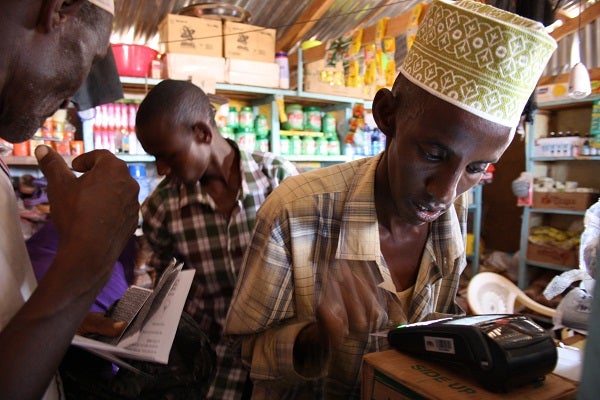Merchant Incentives in the Shift to Cashless Food Aid
In the last decade, many governments and donors have started delivering social support payments electronically rather than using cash or in-kind distributions of food or other items. One example of an institution making this shift is The Word Food Programme in Kenya. Under its “Cash Lite” program, WFP Kenya supports its beneficiaries by issuing debit cards linked to a personal account rather than distributing food resources [also see CGAP Case Study]. This shift to electronic payments has several benefits:
- E-payments give customers the power to choose what they consume and find greater diversity of food items in local shops;
- Consumers face less social stigma from participating in the food benefit program since they can shop when they want and use payment channels that are used by the general population as well.;
- Electronic payments do not disrupt the local economy the way direct food aid can, which floods the market with free supply and competes with local merchants.
- Unbanked, low-income beneficiaries receive an introduction to formal financial services, easing access to banking services and cashless payment systems, and sensitizing consumers to a responsible handling of banking cards and PIN.
- Providers of social support may enjoy reduced programmatic and delivery costs.
- Financial institutions can expand their merchant payment networks.
However, evidence from existing programs shows these financial inclusion benefits can be hard to realize.
 The Cash Lite project in Mata Arba, Isiolo County, Kenya
The Cash Lite project in Mata Arba, Isiolo County, Kenya
Photo Credit: Silvia Baur, Kenya
A first step to turn aid programs into channels for facilitating financial inclusion is ensuring that the consumer experience is positive and improves upon in-kind aid and cash transactions. An important aspect of this is the behavior of merchants and banking agents that handle the cashless transaction channels and provide goods to beneficiaries. This involves non-discriminatory treatment of card users, fair pricing of goods and appropriate handling of cards and PIN numbers by consumers and merchants. For example, in a busy shopping environment, merchants may be disinclined to make the effort to follow security precautions and advise customers on safeguarding their card and PIN.
To address these issues, it is important to understand the incentives that may motivate merchants, banking agents, and customers to behave in unexpected ways that negate the benefits of electronic payments. For example:
- Will merchants impose unregulated fees on card users to make up for the costs of acquiring a point of service (POS) machine and paying transaction fees to the bank?
- In busy shops with long lines, will merchants lose patience with beneficiaries trying to use their cards, mishandling their personal information and refraining from explaining how the card system works?
- Will the sudden transfer of cash into beneficiaries’ accounts create excess demand for products, ultimate leading to scarcity or increased prices?
- If only certain merchants accept the cards, will beneficiaries be less likely to shop around?
- Will we see a “lottery effect” with beneficiaries, where they treat the electronic payments less cost-consciously than “earned” money? Will they feel the loss of this money as much when payments are digitized?
To explore these questions and monitor the effectiveness of electronic payments, in August 2014 the WFP, in collaboration with MasterCard and CGAP, assessed beneficiaries’ shopping experience with new magnet stripe cards for food support. Beneficiaries were sent to different participating merchants to purchase food with the new cards. Using a range of shopping scenarios, beneficiaries measured key aspects such as pricing of items, protection of PIN and other sensitive information, and treatment of known beneficiaries versus other shoppers. The “mystery shopping” visits provided a range of information useful to understanding the challenges mentioned above and how to set incentives right across all participants in an electronic payment program:
Price awareness of consumers:
In the WFP Kenya field study there were indications of positive effects on shoppers’ price sensitivity by mandating itemized receipts from POS devices. Beneficiaries who requested itemized receipts and were asked to recall cost of items after their shopping self-reported increased attention to prices. One beneficiary in Isiolo told the research team that she had learned to ask for prices before the shopping and compare them among merchants, whereas before she had just accepted whatever price the merchant offered. Prompting beneficiaries—in person, by SMS, or with simple budgeting sheets—to plan purchases and write them down before shopping visits may be a light-touch way to increase price sensitivity and maximize food purchased with aid received.
Merchant upcharging:
Some shoppers reported additional charges to card-users compared to past visits to that same merchant where they had paid in cash. Merchants also showed variance in the prices charged for the same item across customers. However, most consumers reported not negotiating on prices, which contrasted with usual shopping behavior in Kenyan markets. This could be due to the “lottery effect” described above or a rush of demand created by many beneficiaries visiting a few merchants in a single day. To address this, the introduction of mandatory itemized receipts—perhaps even branded with the WFP logo—could strengthen beneficiaries’ capacity to protect themselves from additional charges and put merchants on alert that their pricing is being monitored.
Prohibited items:
While most merchants did not, several merchants allowed beneficiaries to buy non-permitted products (such as alcohol, handbags, and perfume).
PIN security:
Several merchants did not fully protect PIN information of beneficiaries, entering the information themselves or asking beneficiaries to leave their PIN and/or card with them.
For the prohibited items and PIN security issues, a possible remedy could be to integrate mystery shopping on a permanent basis into the program. This could involve creating an award system for merchants that comply with these good practices where mystery shoppers provide them with “good practice” stickers or certificates when they refuse to sell non-permitted items or make consumers enter their PIN in the POS device on their own.
While these findings are preliminary and from a small pilot study, they may indicate that further tweaks to the delivery of electronic payment programs can increase beneficiary welfare, improve merchant behavior, and hopefully set these card users on the road to using formal financial products to both provide food for their families, and begin a journey towards greater financial inclusion.




Add new comment